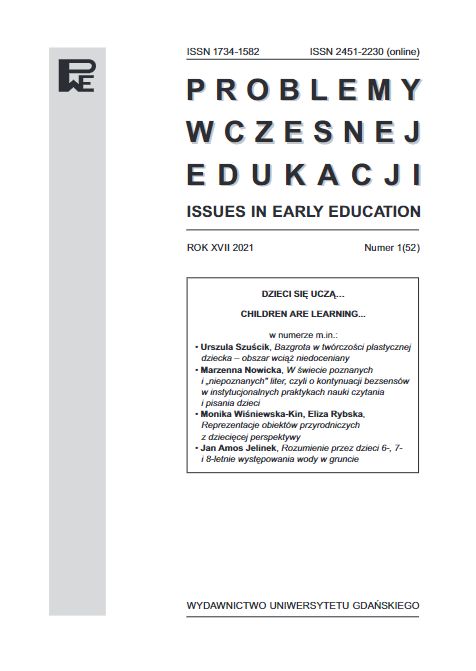Reprezentacje obiektów przyrodniczych z dziecięcej perspektywy
DOI:
https://doi.org/10.26881/pwe.2021.52.03Słowa kluczowe:
konceptualizacja, wizualizacja, kod werbalny i wizualny, dziecięca wiedza osobistaAbstrakt
In presented article we have described examples of children’s strategies for meaning fulfilment in the verbal and visual code. In conducted research, we attempted to reconstruct children’s abilities of conceptualizing objects with (1) prototypical, (2) prototypical and individual features, and (3) nonprototypical features. We were interested also in children’s methods of categorization (recognizing an object at various levels of abstraction) and constructing knowledge in terms of selected domains (appearance, environment, behavior and the relationship between animals and humans). 170 children of two age groups (3/4 and 4/5 years old) participated in the study. They were first asked to recognize an object on the basis of selected features shown in pictures. Then children were interviewed and asked to make a drawing. Research has shown that exposing children to a fragment of an image allows them to recognize the whole object and express their personal knowledge. The presented research showed also that children make conceptualization mainly through personal experiences and that when describing animals, children focus on observable animal activity and behavior, as well as animal appearance, size, the environment of living and the relation with humans.
Downloads
Bibliografia
Ainsworth S., Prain V., Tytler R. (2011), Drawing to learn in science. „Science”, 333(6046).
Angrosino M. (2009), Obserwacja w nowym kontekście. Etnografia, pedagogika i rozwój problematyki społecznej. W: N.K. Denzin, Y.S. Lincoln (red.), Metody badań jakościowych. T. 2. Warszawa, Wydawnictwo Naukowe PWN.
Barsalou L.W. (2008), Grounded Cognition. „Annual Reviews of Psychology”, 59.
Bell B. (1981), When is an animal not an animal? „Journal of Biological Education”, 15.
Błaszak M. (2013), Ekotypy poznawcze człowieka. Przyczynek do kognitywistycznej teorii poznania. Poznań, Bogucki Wydawnictwo Naukowe.
Bornstein M.H., Hahn C.-S., Suwalsky J.T.D. (2013), Physically developed and exploratory young infants contribute to their own long-term academic achievement. „Psychological Science”, 24.
Braund M. (1991), Children’s ideas in classifying animals. „Journal of Biological Education”, 25.
Carey S. (1985), Conceptual change in childhood. Cambridge, MIT Press.
Clark A. (1997), Being there: Putting brain, body, and world together again. Cambridge, MIT Press.
Clark A., Chalmers D. (1998), The Extended Mind. „Analysis”, 58 [tłum. pol.: (2008), Umysł rozszerzony. W: M. Miłkowski, R. Poczobut (red.), Analityczna metafizyka umysłu. Najnowsze kontrowersje, przeł. M. Miłkowski. Warszawa, Wydawnictwo IFiS PAN].
Coren S., Girgus J.S. (1980), Principles of perceptual organization and spatial distortion: the gestalt illusions. „Journal of Experimental Psychology: Human Perception and Performance”, 6(3).
Dellatolas G., De Agostini M., Curt F., Kremin H., Letierce A., Maccario J., Lellouch J. (2003), Manual skill, hand skill asymmetry, and cognitive performances in young children. „Laterality: Asymmetries of Body, Brain and Cognition”, 8(4).
Duch W. (2009), Reprezentacje umysłowe jako aproksymacje stanów mózgu. „Studia z Kognitywistyki i Filozofii Umysłu”, 3. Evans V. (2009), Leksykon językoznawstwa kognitywnego. Kraków, TAiWPN Universitas.
Feldman-Barrett L. (2018), Jak powstają emocje. Sekretne życie mózgu. Warszawa, CeDeWu.
Graham L. (2008), Gestalt theory in interactive media design. „Journal of Humanities & Social Sciences”, 2(1).
Habrajska G. (2016), Dopełnianie sensu w kodzie werbalnym i wizualnym. W: G. Habrajska, J. Ślósarska (red.), Strategie twórcze w działaniu. Łódź, Primum Verbum.
Hurley A. (2005), Cognitive Development: Overview. https://resources.saylor.org/wwwresources/ archived/site/wp-content/uploads/2011/07/psych406-5.3.pdf, 12.01.2020.
Hutto D.D., Myin E. (2013), Radicalizing Enactivism: Basic Minds without Content. Cambridge MA, MIT Press.
Kępa-Figura D. (2007), Kategoryzacja w komunikacji językowej (na przykładzie leksemu ptak). Lublin, Wydawnictwo Uniwersytetu Marii Curie-Skłodowskiej.
Kirsh D. (2013), Poznanie ucieleśnione i magiczna przyszłość projektowania interakcji. „AVANT. Pismo Awangardy Filozoficzno-Naukowej”, (2).
Klus-Stańska D. (2010), Dydaktyka wobec chaosu pojęć i zdarzeń. Warszawa, Wydawnictwo Akademickie Żak.
Laakso A. (2011), Embodiment and development in cognitive science. „Cognition, Brain, Behavior. An Interdisciplinary Journal”, 15(4).
Maruszewski T. (2008), Psychologia poznania. Umysł i świat. Gdańsk, GWP.
McLuhan M. (2004), Zrozumieć media. Przedłużenia człowieka. Warszawa, Wydawnictwa Naukowo-Techniczne.
Meltzoff A.N. (1990), Towards a developmental cognitive Science – The implications of cross-modal matching and imitation for the development of representation and memory in infancy. „Annals of the New York Academy of Sciences”, 608.
Paul-Cavallier F.J. (1994), Wizualizacja. Od obrazu do działania. Poznań, Rebis.
Rybska E., Błaszak M. (2016), Analiza rysunków/szkiców i wypowiedzi werbalnych dzieci na temat budowy anatomicznej człowieka. „Problemy Wczesnej Edukacji”, 32(1).
Shepardson D.P. (2002), Bugs, butterflies, and spiders: children’s understandings about insects. „International Journal of Science Education”, 24(6).
Sternberg R.J. (2001), Psychologia poznawcza. Warszawa, WSiP. Tunnicliffe S.D. (1995), Talking about animals: studies of young children visiting zoos, a museum and a farm. London, King’s College.
Tunnicliffe S.D., Reiss M.J. (1999), Building a model of the environment: how do children see animals? „Journal of Biological Education”, 33(3).
Tversky B. (2019), Mind in motion, How action shapes thought. New York, Basic Books.
Ward D., Stapleton M. (2012), Es are good: Cognition as enactive, embodied, embedded, affective and extended. W: F. Paglieri (ed.), Consciousness in interaction: The role of the natural and social context in shaping consciousness. Amsterdam, John Benjamins Publishing House.
Whitmore D. (1994), Radość uczenia się. Warszawa, Medium.
Wierzbicka A. (1985), Lexicography and Conceptual Analysis. Ann Arbor, Karoma Publishers.
Wierzbicka A. (1993), Nazwy zwierząt. W: J. Bartmiński, R. Tokarski (red.), O definicjach i definiowaniu. Lublin, Wydawnictwo Uniwersytetu Marii Curie-Skłodowskiej.
Wiśniewska-Kin M., Rybska E. (2020), Świat w optyce dziecka. Reprezentacje obiektów przyrodniczych z dziecięcej perspektywy. Łódź, Wydawnictwo Uniwersytetu Łódzkiego.
Zahorodna K. (2015), Problem reprezentacji umysłowych w rozszerzonych systemach poznawczych. Wrocław, Wydawnictwo Fundacji „Projekt Nauka”.

 Uniwersyteckie Czasopisma Naukowe
Uniwersyteckie Czasopisma Naukowe





